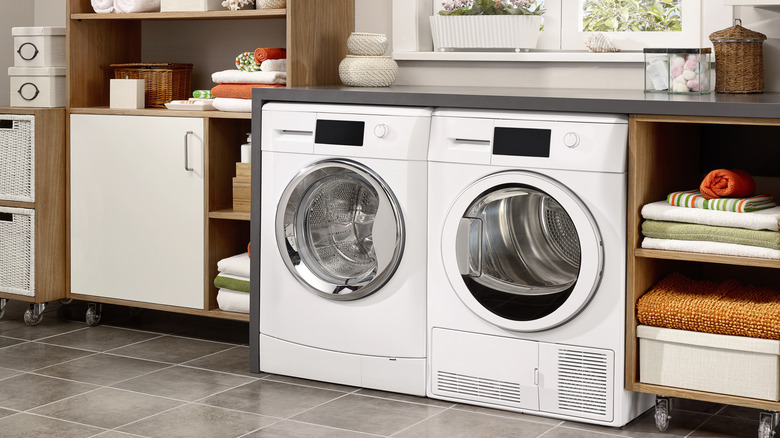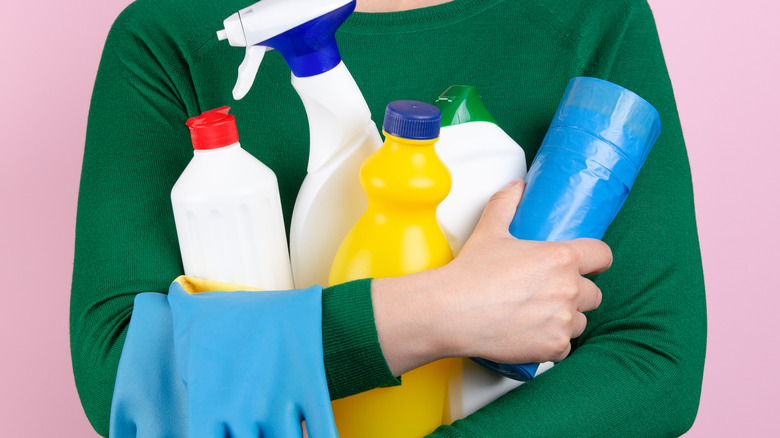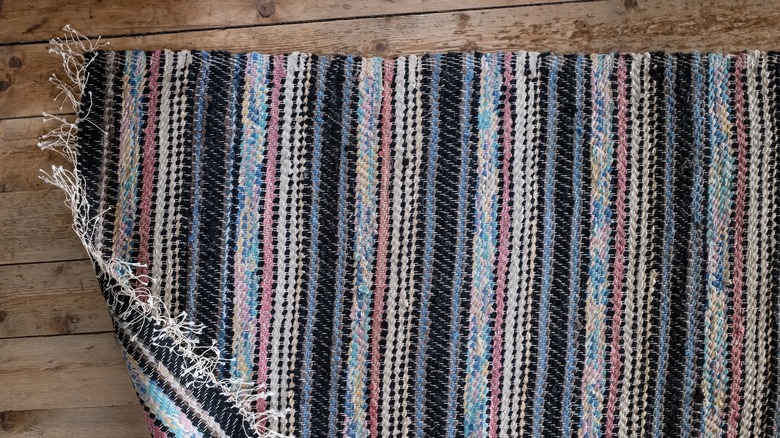Unexpected Household Items That Can Actually Kill You
The world can seem scary, but ideally, our homes should feel like safe havens. However, this isn't always the case.
According to the National Safety Council, deaths that occurred in homes in the United States increased by 13% in 2021. The Council looked at data from 130 million households and found that the number of "preventable injury-related deaths in the home" from that year was 128,200. The Council also found that the majority of these deaths were people who were 25 to 44 years old (the second largest group was 45- to 64-year-olds). In addition, the Council reported that the two leading reasons for these deaths were unintentional poisonings and falls. Other causes included fire-related factors like flames and smoke.
The good news is that there are ways to make your home safer for yourself and your family. We're going to explore some seemingly unlikely but potentially dangerous items in your home. The following list of items will range from rarely fatal to extremely dangerous. Now, keep in mind that just because an item is on this list doesn't mean you have to remove it from your home (although sometimes that should be the case). And if you are worried that you or someone else has been exposed to something that could be hazardous to one's health, seek medical help right away.
Houseplants
Houseplants can be thoughtful gifts and nice additions to a home, but choosing one based solely on its appearance can be a mistake. As Better Homes and Gardens points out, there are poisonous houseplants on the market.
For example, Mount Sinai has instructions on its website for dieffenbachia poisoning. This houseplant is also called dumb cane because eating or even just chewing it can result in one's tongue and throat becoming inflamed to the point that the person is temporarily unable to talk (per Encyclopedia Britannica). In fact, Mount Sinai cautions that dumb cane can swell one's throat and tongue so much that it's possible for the airways to become blocked; however, this is a rare occurrence. Even still, dumb cane can cause a number of unpleasant symptoms, including diarrhea, nausea, vomiting, and blisters inside the mouth.
Call 911 or the national Poison Help hotline at 1-800-222-1222 to reach your local poison control center if either you or someone else "has an exposure" to dumb cane. Other bits of advice include using a cold, wet cloth to wipe the inside of yours or the other person's mouth, thoroughly rinsing the skin and eyes of someone who touches the plant, and bringing the plant with you for a dumb cane-related trip to the ER, if you can.
Mouthwash
As Healthline notes, swallowing a little mouthwash shouldn't be a major problem. For example, if you swallow the mouthwash you were swishing around in your mouth during your oral hygiene routine, probably the worst that will happen is that you'll get an upset stomach.
But swallowing larger amounts of mouthwash is another story. For starters, you can become dizzy or drowsy. Imagine this occurring on a staircase in one's home; the outcome could be extremely dangerous. Also, Mount Sinai, which has a page on its website dedicated to a mouthwash overdose, cautions that consuming a large amount of mouthwash could make one unconscious and even put one in a coma. Other symptoms of a mouthwash overdose can include rapid, shallow breathing or slowed breathing, as well as one's body temperature, blood pressure, and blood sugar dropping. Additionally, a study in the Journal of Intensive Care Medicine described the case of a 45-year-old man who died from drinking close to three liters of mouthwash.
Call 911 or your poison control center right away if you or someone you know has consumed a large amount of mouthwash. Mount Sinai also advises against making yourself or someone else vomit up mouthwash unless a health care professional or someone at the poison control center tells you to do so. Even if only a small amount is swallowed, you can still call the poison control center for advice.
Treadmill
According to Harvard, exercising on a treadmill can help with strength, endurance, and balance, particularly in older adults. This is due to the muscles that treadmills work out, including the hamstrings, the calves, and the quadriceps. However, just because treadmills can be beneficial to one's health doesn't mean they can't also be dangerous.
Physical therapist Michael Silverman told Men's Journal that not using a treadmill properly can result in falling. One common mistake he mentioned is using a cellphone while working out on a treadmill. He explains that doing so can be so distracting that one "can easily wind up at the back of the treadmill without realizing it." Another error is not using the treadmill's emergency shut-off clip. But it's worth noting that even if one uses a treadmill properly, falls can still occur because it's possible to pass out while using a treadmill. As Medical News Today notes, overexerting yourself and/or becoming dehydrated can each result in becoming lightheaded and/or dizzy. Low blood sugar (a.k.a. hypoglycemia) can also make one dizzy, as well as not breathing properly during a workout. Additionally, lightheadedness and/or dizziness could happen just because a treadmill is a continuous movement machine.
Before adding a treadmill to your workout routine, speak with a professional trainer (via Harvard). After all, they can walk you through the features (including the safety ones) of a particular model. Also, don't begin any new fitness program without talking with a health care professional first.
Water heater
As the CDC explains, carbon monoxide (CO) is very dangerous. Exposure to this colorless, odorless gas could lead to death. What's more, different items commonly found in the home produce this gas.
According to Forbes, if you have a fuel-burning water heater, then it produces CO. Such appliances are designed to safely vent their CO, so it winds up outside one's home. However, if the water heater is unable to properly vent the CO it produces (e.g., its venting system becomes blocked), that can create a deadly scenario. Besides blockage, rust can also compromise a water heater and cause CO to leak out of it. As USA Today reported in 2018, a family of four died because of a faulty water heater and CO exposure while on a trip in Mexico. Police took apart the water heater and found rust, which was why the appliance had malfunctioned.
To help protect your home from CO, the CDC advises using CO detectors and recommends either battery-operated or battery backup ones being installed just about anywhere in your home where someone might sleep. Note: The CDC uses the terms CO detector and CO alarm interchangeably. Also, the CDC says to put new batteries in these detectors twice a year when you change your clocks in the fall and in the spring. Lastly, make sure to have your water heater serviced annually, and be sure it's by a qualified technician.
Clothes dryer
While clothes dryers can be very helpful modern conveniences, the U.S. Consumer Product Safety Commission notes that there are multiple ways they can be deadly.
For one, lint can be especially dangerous; if it accumulates inside the dryer and/or its exhaust pipe, that can create the ideal situation for a fire to occur. This is why it's so important to clean a dryer's lint screen and filter, either when you've finished drying one load of clothing or before you start drying the next load of clothing. You should also regularly check the exhaust vent to make sure that it's not blocked. One way to do this is to run the dryer and then observe if the vent is properly venting exhaust air. Additionally, the Commission recommends replacing "plastic or foil, accordion-type ducting material with rigid or corrugated semi-rigid metal duct" since the latter has better airflow than the former. Also, be careful about putting clothing that is stained with volatile chemicals like cooking oils and cleaning agents in a dryer, since that could also cause a fire.
Besides possibly causing a fire, the Commission warns that children have died because they went inside washer and dryer units. In 2018, the Associated Press covered one such case where a third grader hid in a tumble dryer while playing hide-and-seek and was fatally electrocuted.
Household cleaners
To be clear, we're not suggesting you stop using household cleaners. However, as Healthline explains, mixing certain cleaners together can create a potentially deadly situation. Such was the case in 1996 when two women combined certain cleaners and died from the resulting fumes (via the New York Times).
As Healthline notes, some cleaners contain ammonia and others contain bleach. However, per the American Lung Association, one should never mix together ammonia and bleach because that can result in toxic and potentially deadly fumes. What's more, the Washington State Department of Health cautions that breathing in these fumes can cause symptoms like shortness of breath, chest pain, nausea, fluid in the lungs, wheezing, and coughing. These fumes can also result in chronic breathing problems. Irritation to the eyes, throat, and nose might also occur.
The fumes from mixing bleach and ammonia can overwhelm a person within minutes. Thus, it's important to quickly get yourself and anyone who has been exposed to the fumes to somewhere that is both safe and well-ventilated. This is especially important if anyone has become unconscious because of their exposure to the fumes. Don't hesitate to call 911, especially if someone has lost consciousness and/or you or someone else is having trouble breathing. Also, call your poison control center; they can guide you through safely cleaning up the mixture. Finally, opening windows and running fans might help with the fumes.
Carpets and rugs
Comedian Jimmy Fallon learned that an accent rug can become an accident rug. In 2015, the Tonight Show host tripped on a braided rug in his kitchen, and as a result, his finger was ripped from its socket (via Entertainment Weekly). While this injury wasn't fatal, research shows that rugs and carpets can be dangerous, especially in homes with senior citizens.
A 2013 study in the Journal of Injury and Violence Research analyzed data spanning 2001 to 2008 from 66 U.S. hospitals. The focus of the research was on adults 65 years old or older being treated in emergency departments due to injuries from falls. Based on this information, the researchers estimated that U.S. emergency departments treat around 38,000 adults in this age group on an annual basis because of falling due to carpets or rugs. Additionally, more than 70% of these fall-related injuries happened in the home. Although this survey focused on nonfatal injuries, the National Institute on Aging explains that if a senior citizen trips on a rug, that could result in a broken bone or bones, potentially leading to hospital confinement, disability, or death.
Fortunately, as the study notes, one can use tape or non-skid backing to help keep rugs in place, and it's possible to fix a carpet that has curled edges. But if a rug or carpet can't be effectively secured or repaired, then discarding it might be the best option.








